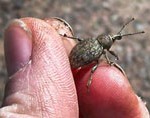 ASB PEST STATUS, DIET, and IMPACT
ASB PEST STATUS, DIET, and IMPACT
Alfalfa snout beetle has been identified in nine counties (Clinton, Essex, Franklin, Jefferson, Lewis, Northern Cayuga, Oswego, St. Lawrence, and Wayne County) in New York State, and in parts of Ontario, Canada. At one time, an estimated 500,000 acres of land in NY was infested by ASB.
In addition to alfalfa, ASB feeds on red and white clover, broad-leafed dock, wild carrot, wild strawberries, blackberries, dogwood, other legumes and weeds.
ASB can destroy an entire stand of alfalfa within one growing season, resulting in economic impact due to forage crop, cash crop, and milk production losses. At the start of the NNYADP-funded research to find a way to manage ASB, one farm estimated a 25% rise in milk production costs due to feed replacement costs.
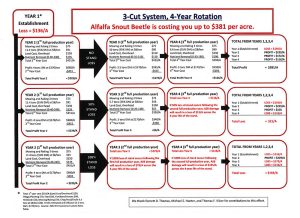
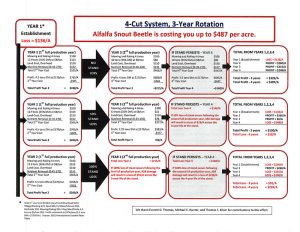
Left: In a 3-cut system, 4-year rotation, ASB can cost a producer up to $381/acre if 100% stand loss.
Right: In a 4-cut system, 3-year rotation, ASB cab cost a producer up to $487/acre if 100% stand loss occurs.
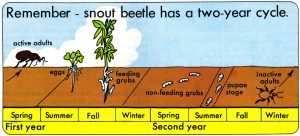
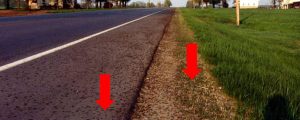
ASB LIFE CYCLE
Year 1
May: Adult beetles emerge and feed on alfalfa foliage for three weeks to build fat reserves for egg laying.
May-June: Adults enter a non-feeding dispersal phase, laying eggs at the base of host plants. One adult can lay up to 500 eggs.
June-November: ASB larvae feed on alfalfa plant roots, the most heavily damaged plants begin to die in August. Remaining plant death occurs in September-October. In November larvae burrow deep into the soil for a full year, they become adults the following summer.
Year 2
April-May: Alfalfa stand loss is seen, field are patchy or barren. Surviving plants may fill in quickly and areas may not be seen as damaged.
June-Aug: ASB larvae remain in hibernation but finish developing and turn into adults. ASB previous year feeding damage often looks like winter kill following spring.
April-May: ASB that began in Year 1 now emerge in alfalfa fields as adults.
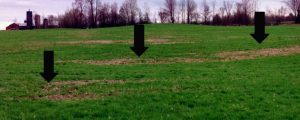
ASB MANAGEMENT
After ASB was introduced into New York State in 1896 (see history/timeline), different management methods were attempted. From 1939 to 1972, populations of the ASB were managed using poison baiting methods and heptachlor. In 1972, these methods were banned due to concern of environmental contamination, and from 1976 to 1986, ASB populations began to explode over a large area. It was not uncommon for 2 million beetles per acre to exist.
In 1988-1989, potential insecticides were evaluated as a stop-gap management option, but did not end up being an effective management tool. In the 1990s, the farmer-driven Northern New York Agricultural Development Program championed the cause of finding a solution to alfalfa snout beetle through research conducted by Cornell University entomologist Elson Shields and Research Support Specialist Tony Testa (timeline of that research).
On the way to developing the science behind the use of persistent biocontrol nematodes for ASB management, other means of management ASB populations were applied, as follow.
Crop Rotation
- ASB populations on a farm can be managed and kept to a reasonable level by limiting alfalfa stand life to only 3 years.
- Simply adding a 4th year to the stand allows the ASB population to explode to very high levels.
- The 3 years are considered the seeding year and 2 production years. Then the stand is plowed down and planted to a non-host (corn or soybeans) for at least 2 years.
- When effective rotation is used, farmers are required to plow down an economically viable alfalfa stand.
ASB-Resistant Alfalfa Variety Breeding
- Cornell University plant breeders Don Viands, Julie Hansen, and Jaime Crawford focused intense effort on the identification of potential resistance in alfalfa to snout beetle larval root feeding. This research by the Cornell Forage Breeding Program in collaboration with the ASB research by Dr. Elson Shields ws supported by grants from the NNYADP. Seedlings were screened for ASB larval resistance in the greenhouse, promising plants intercrossed, and promising experimental lines tested in on-farm field trials against ASB populations.
- Field results led to the first variety with moderate resistance, Seedway 9558 SBR, that was made commercially available to growers.
- Field trials to test unselected populations against select populations in ASB infested land allowed researchers to observe significant increases in yield and a reduction in root feeding damage.
- As results of field experiments progressed, continued development of ASB-resistant varieties showed higher resistance to ASB damage. Resistant varieties in combination with nematodes that reduce snout beetle populations is the best control option for producers.
- NNYADP Breeding ASB-Resistant Alfalfa project reports
2017
2014-2015 Report: Tables Photos
2012-2014 Report: Photos, Table 2: 2013 and 2014 yields,
2014: Yields/% ASB-resistance table
2012 report
Management Recommendations (2016)
We believe both biological control with biocontrol nematodes and the planting of ASB-resistant alfalfa varieties will be required to effectively reduce alfalfa snout beetle populations to sub-economic levels. Biological control nematodes are required to reduce the very large populations to a lower level and ASB-resistant alfalfa will be required to maintain the insect at the lower sub-economic level.
- Alfalfa Stand Age:
We recommend that biocontrol nematodes should be applied on alfalfa fields in their seeding year, or 1st production year, for the best economic impact. If biocontrol nematodes are focused on this age of fields each year, the entire farm will be treated within 3-5 years and the cost of treatment can be spread out over the same time period. However, if farmers choose to apply biocontrol nematodes to more established alfalfa fields, the biocontrol nematodes will establish and attack snout beetle larvae present, but will not assist with stand retention of the alfalfa stand. - Application Timing:
Since the biocontrol nematodes need to be applied to the soil surface but have some shading from sunlight until they enter the soil, we recommend that the applications be made to alfalfa fields 2-3 weeks after harvest. This allows about 6″ of regrowth which shades the soils surface while allowing the stream of water from the sprayer to easily contact the soil surface. In addition, applications should be made late in the day (after 6 pm) or during cloudy and/or rainy days to minimize nematode death from intense UV sunlight. Applications need to be made before September 1st.
Nozzle Spacing:
Nematodes will be applied using the “skip nozzle” method, leaving every third nozzle open and nematodes will be applied to 33% of the acreage driven over by the application equipment (based on nozzle separation of 22-24”).
Click on the links below to learn more (2023):
Persistent Biocontrol Nematodes for Pest Management
Persistent Biocontrol Nematodes Rearing and Application Protocols Development Timeline
Persistent Biocontrol Nematode Application Techniques
Persistent Biocontrol Nematodes Resources: Instructional Manuals & Videos